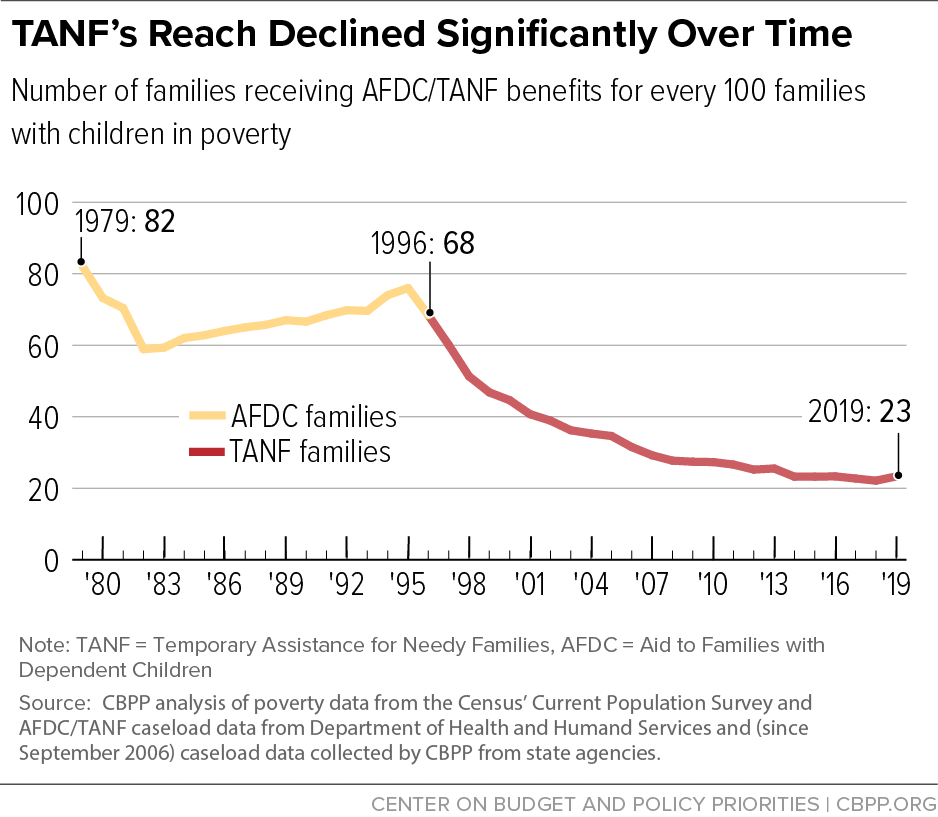Sanjana writes*
The Temporary Assistance for Needy Families (TANF) program is America’s largest cash assistance program for low-income families. It was enacted in 1996 to replace the Aid to Families with Dependent Children program created in 1935. TANF provides block grants to states that use the funds to pay for their welfare programs. The TANF budget, originally set at $16.5 billion, has not been adjusted for inflation, which means its real value has fallen by 40 percent since 1996. States are allowed to allocate TANF funds among different services such as basic income, work support, education, and childcare. The TANF has four aims: (1) helping low-income families care for children at home, (2) promoting training and education to help families get off welfare, (3) preventing “out-of-wedlock” pregnancies. and (4) encouraging two-parent families.
TANF was designed to reach fewer families than AFDC. In 1979, 82% of poor families with children received AFDC benefits. In 1996, 68% of eligible families received TANF benefits. States can set their own eligibility requirements for TANF services, further reducing access. In 2019, only 23% of eligible families received support. This figure illustrates the negative trend:
The U.S. Department of Health and Human Services says work requirements have led to 2 million Americans losing their benefits since 1997. Work requirements and federal regulations mean TANF programs do not provide enough educational and training assistance. The 1996 federal law allows 12 categories of work activities to be accepted in order to qualify for TANF benefit. The law limits activities such as job searching to qualify for full assistance. Furthermore, education and training can only be accepted as work activities if it is done along with 20 hours of work from one of the 12 listed categories in the 1996 law.
Another federal requirement, time limit, prohibits states from giving benefits for longer than 60 months to families with an adult recipient, making TANF an inadequate, unreliable safety net for low-income families.
Bottom Line: TANF’s strict requirements prevent many low-income families with children from receiving help.
* Please help my Economic Growth & Development students by commenting on unclear analysis, alternative perspectives, better data sources, or maybe just saying something nice :).

Hi Sanjana,
This does indeed sound like something that would happen under the Clinton administration — welfare reform was one of his big things, and if I recall correctly he really tried to work with republicans which meant “welfare reform” meant more focus on personal responsibility and an emphasis on “work-fare”, which in turn basically meant the kind of welfare cuts you’re pretty much describing.
I was wondering on the state level if this TANF program was MORE effective in some states than the federal AFDC predecessor — since at the state level I would think Democratic States would try to promote welfare more (maybe) while Republican States would try to be more stubborn about it to reduce payouts. The idea that the states are more effective than the federal gov in implementing policy is always a huge talking point so I was wondering if it maybe applied here.
Hi Thomas,
You are absolutely right. During the Reagan administration and the beginning of the Clinton administration, the AFDC (which was the previous cash assistance program) was heavily criticized as it: (1) allegedly promoted welfare dependency; (2) increased caseload; (3) was ineffective in promoting employment. As a result, Clinton began to formulate a welfare reform during 1992 and pledged to “end welfare as we know it”. The bill was introduced in 1994 at the same time the Republican party won a majority in Congress. As it was debated in Congress, the main points of contestation were: (1) To promote work requirements and time limits; (2) to address out-of-wedlock pregnancies; (3) how much involvement should be made at the federal level. Clinton vetoed the reform bill twice but agreed to it the third time. However, for this reform to have taken place, Clinton had to compromise with the Republicans.
States are given a tremendous amount of freedom over the TANF program, which means states such as California have relatively effective programs that dedicate 34% to direct cash assistance compared to Main or Arizona who steadily made cuts to their TANF due to alleged welfare dependence.